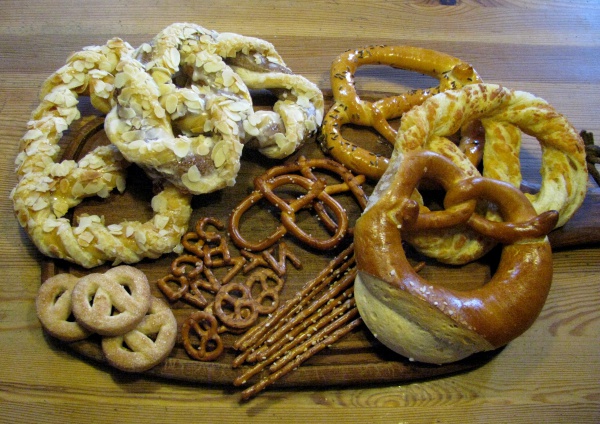Facts About Pretzel
A pretzel is a type of baked pastry that originated in German-speaking regions, crafted from dough typically twisted into a distinctive knot shape. The classic pretzel form is symmetrical, featuring intertwined ends of a long strip of dough twisted back onto itself. Pretzels are most commonly seasoned with salt, complementing the washing soda or lye treatment that imparts their distinctive skin and flavor through the Maillard reaction. Other popular seasonings include cheese, sugar, chocolate, cinnamon, sweet glazes, seeds, and nuts. There are two main types of pretzels: soft pretzels, best eaten fresh, and hard-baked pretzels, which have a longer shelf life.
The exact origins of pretzels are somewhat mysterious, with many stories attributing them to European monks. Historically, pretzels have been linked to Christian symbolism and have served as emblems for bakers and guilds. In Germany, pretzels are especially significant during Lent and Easter. The traditional pretzel shape also had practical uses, such as being hung on sticks for display.
Pretzel baking has a rich history in Upper German-speaking regions, particularly in Franconia and surrounding areas. Lye pretzels are especially popular in southern Germany, Alsace, Austria, and German-speaking Switzerland, each region boasting its own varieties and toppings. In the United States, pretzels were introduced by the Pennsylvania Dutch in the late 18th century, leading to the establishment of pretzel bakeries in central Pennsylvania. Soft pretzels became especially popular in cities like Philadelphia, Chicago, and New York.
The pretzel industry in the U.S. is quite significant, with Pennsylvania being a major producer. Hard pretzels, which originated in the U.S., come in various shapes and flavors and have become a popular snack worldwide. Pretzels are celebrated in festivals and events, such as National Pretzel Day in Pennsylvania.
Pretzels are enjoyed in many other European countries and around the world, each with their own names and variations. The pretzel has even influenced popular culture, making appearances in art, fashion, dance, and politics. Its unique shape and cultural significance continue to be celebrated and adapted in various forms across different regions and industries.

 Serbia
Serbia